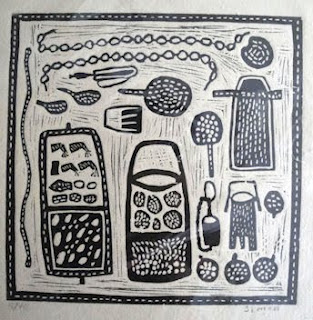Simon Hampolo is amongst the older men of the group and is called Tate Simon, meaning ‘Father Simon’. He is 55 years old. He was born in Omule, south east of Eenhana and as a little boy of 8 started working at a cattle post. He worked there for 3 years then went to school in 1966 at Okongo where he stayed in a hostel. He got to grade 8 which is quite an achievement amongst his peers – school is a luxury that few can afford to continue at the expense of working and making money.
However it is clear that Simon could have gone far in school – he assists the art teacher of the Ekoka workshops by acting as a translator as he speaks some English and Afrikaans.
After his schooling career he started working at various odd jobs, including work in a butcher’s shop, in order to support his family. At the age of 28 he got married in a church and has 7 children and has worked continually to provide for their needs.
He feels that everyone has changed through their participation in the art project and has faith in it as a steady source of income. He also feels however that not everybody is using the money properly.
Simon is an adept linocutter as we can see from the examples of his work below. His forms are clean, carefully depicted and highly detailed and his spacing has an organized quality.
I find his work extremely engaging as it seems to convey an overall atmosphere of cheerful competence and delight in working. Both examples follow the ‘display of goods’ format and exhibit a high level of care taken in their execution. In the work below (edition 12/40) we can see a large number of craft goods displayed in an extremely successful composition.
Easily identified amongst the many pictograms is an intricately ornamental bag, and beautifully depicted strings of beads. There are other objects all highly detailed and embellished whose function I am less sure of. There appear to be objects much like maracas –decorated gourds filled with seeds and used as musical instruments, as well as many curiously formed containers – each no doubt with some very specific use.
His second linocut (9/40) runs along similar lines but contains some incredibly rendered insects. His two centipedes are truly fantastic in the carefully segmented and many-legged detail and even his adorable scorpion has been highly embellished. Next to them are many patterned objects, no doubt rocks, and amongst them what I am convinced is the fossil of a fish – a rock on which the tiny body of a beautifully observed fish has been rendered.
The layout of his various objects displays an incredible natural sense of design and harmonious balance and it is clear that in art making he has found an outlet for highly sensitive observational skills.
However it is clear that Simon could have gone far in school – he assists the art teacher of the Ekoka workshops by acting as a translator as he speaks some English and Afrikaans.
After his schooling career he started working at various odd jobs, including work in a butcher’s shop, in order to support his family. At the age of 28 he got married in a church and has 7 children and has worked continually to provide for their needs.
He feels that everyone has changed through their participation in the art project and has faith in it as a steady source of income. He also feels however that not everybody is using the money properly.
Simon is an adept linocutter as we can see from the examples of his work below. His forms are clean, carefully depicted and highly detailed and his spacing has an organized quality.
I find his work extremely engaging as it seems to convey an overall atmosphere of cheerful competence and delight in working. Both examples follow the ‘display of goods’ format and exhibit a high level of care taken in their execution. In the work below (edition 12/40) we can see a large number of craft goods displayed in an extremely successful composition.
Easily identified amongst the many pictograms is an intricately ornamental bag, and beautifully depicted strings of beads. There are other objects all highly detailed and embellished whose function I am less sure of. There appear to be objects much like maracas –decorated gourds filled with seeds and used as musical instruments, as well as many curiously formed containers – each no doubt with some very specific use.
His second linocut (9/40) runs along similar lines but contains some incredibly rendered insects. His two centipedes are truly fantastic in the carefully segmented and many-legged detail and even his adorable scorpion has been highly embellished. Next to them are many patterned objects, no doubt rocks, and amongst them what I am convinced is the fossil of a fish – a rock on which the tiny body of a beautifully observed fish has been rendered.
The layout of his various objects displays an incredible natural sense of design and harmonious balance and it is clear that in art making he has found an outlet for highly sensitive observational skills.


















